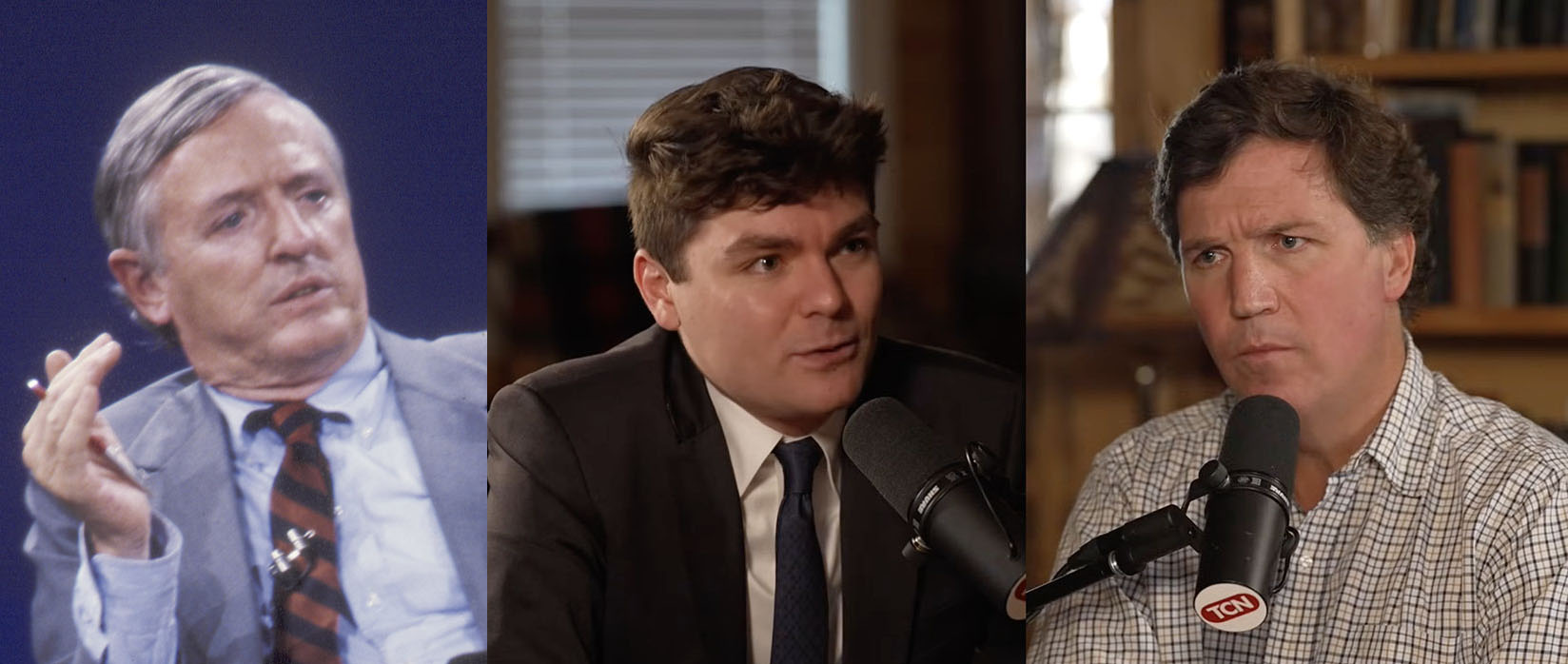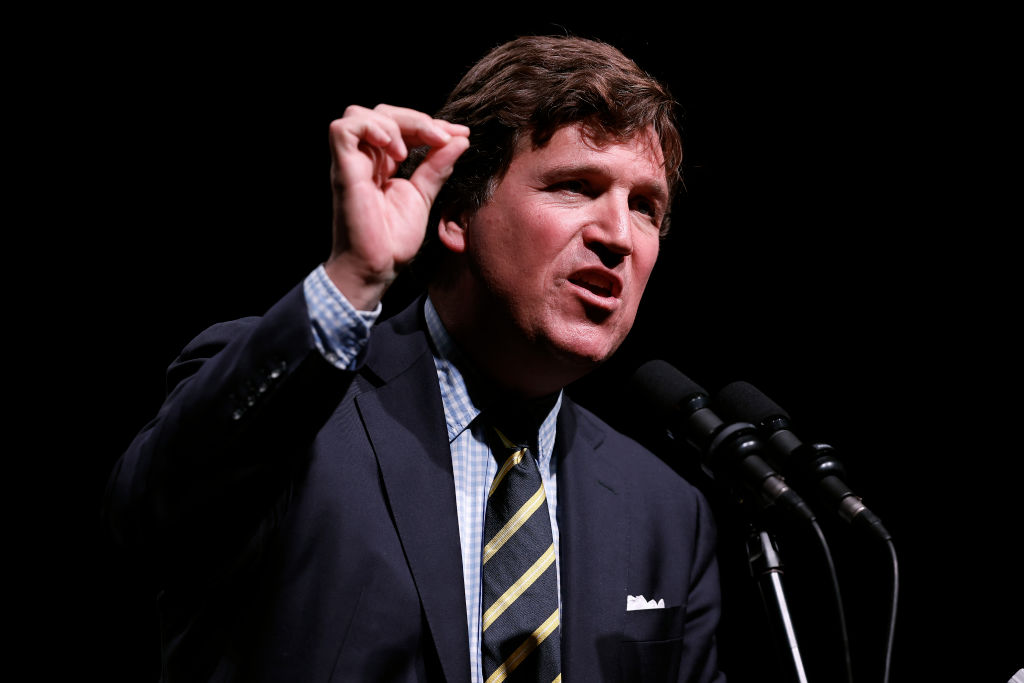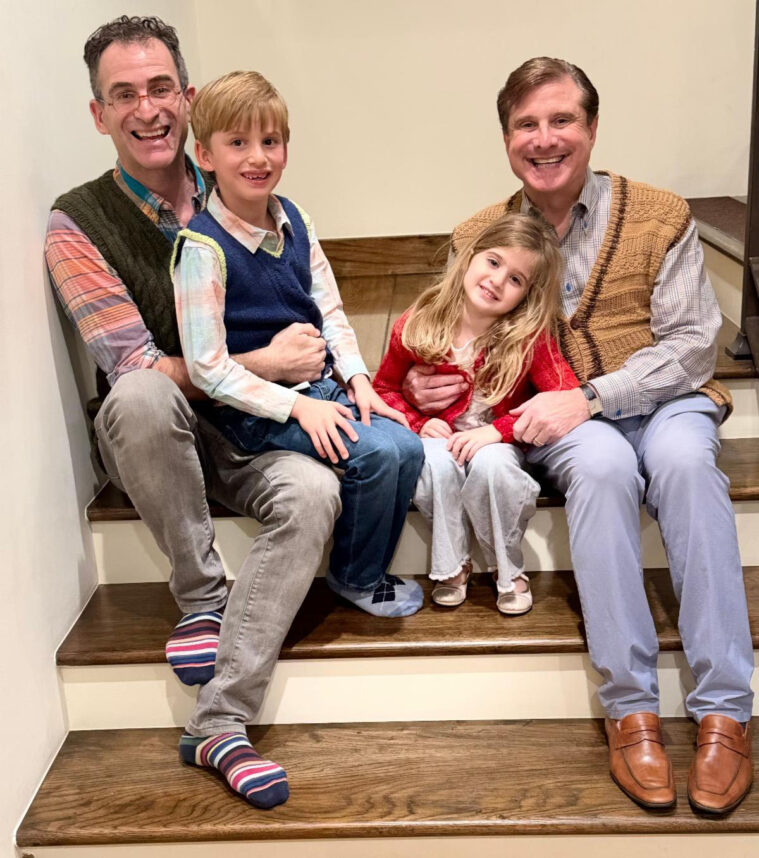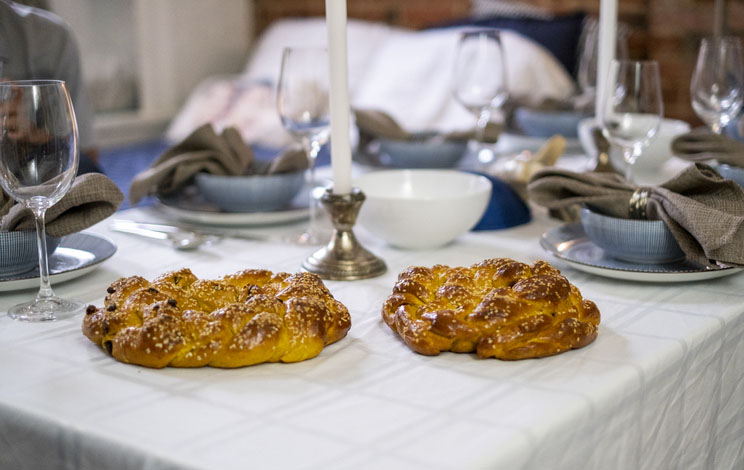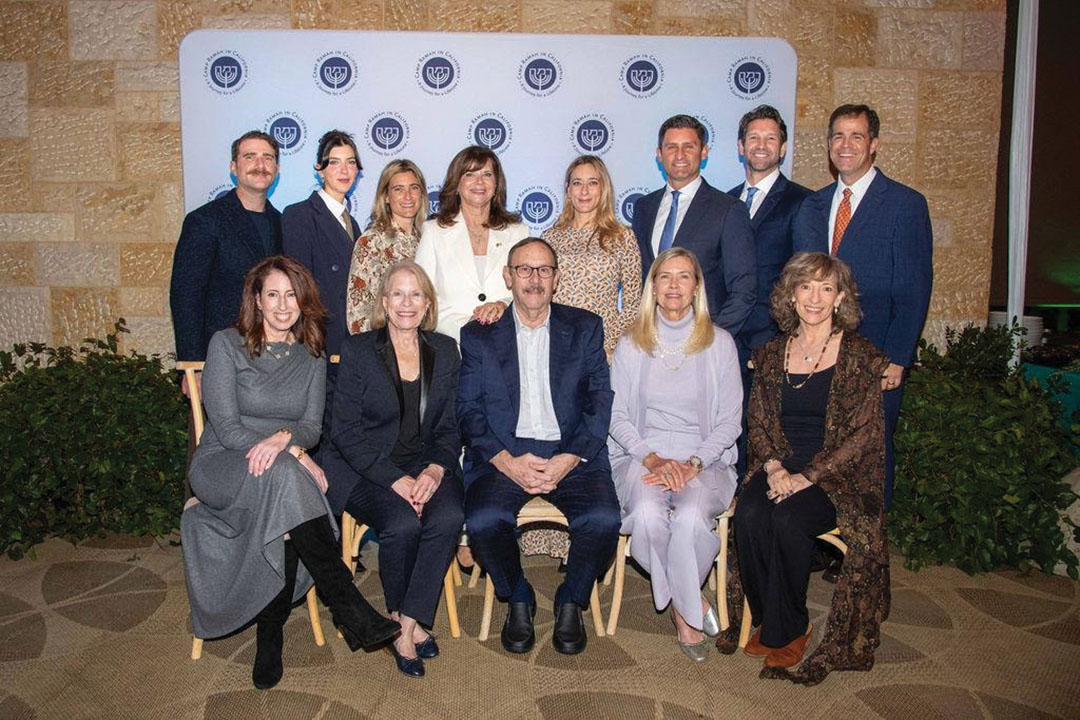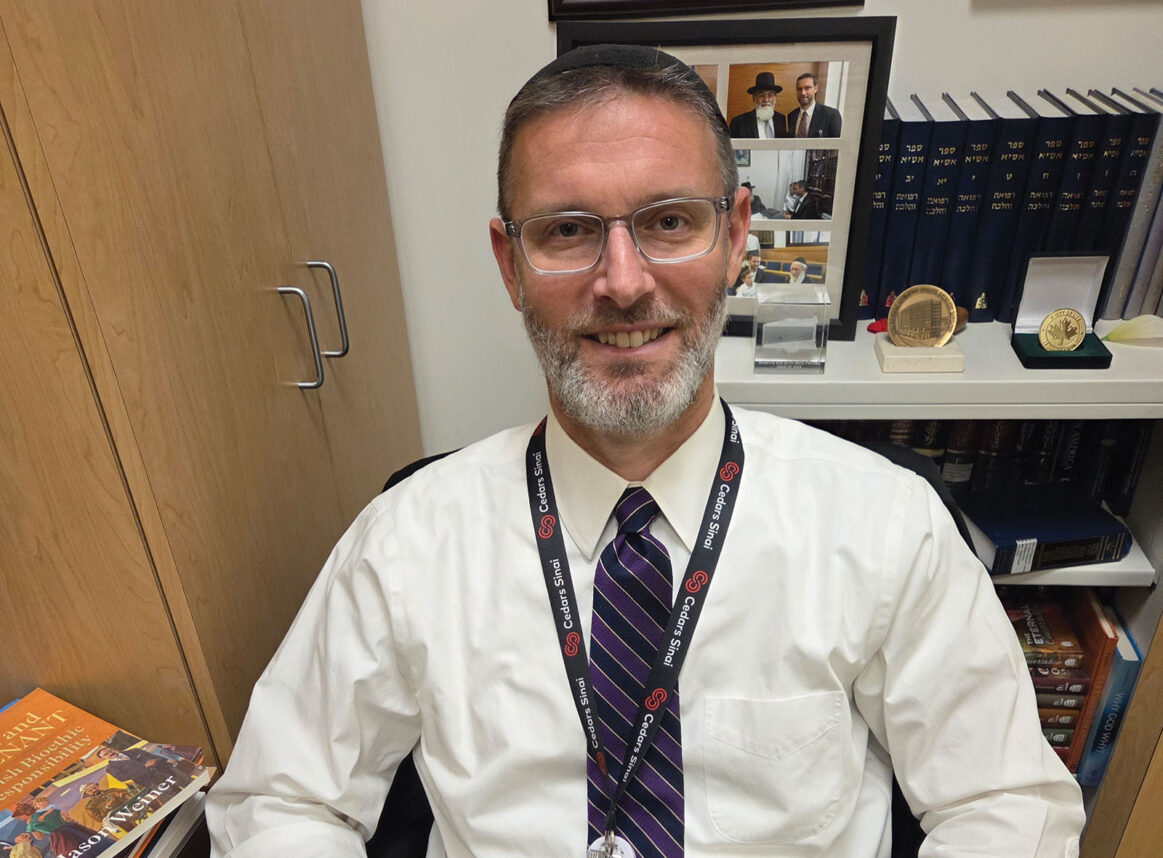
From left: Herb Alpert in the studio with Lou Adler in 1970. Photo courtesy of Herb Alpert Presents
About a mile north of Duke’s in Malibu, a right turn takes you up to a bluff with its own driveway, which leads to a large parking lot. There, on the day I visited, a tour bus was parked in front of a modest ranch house, alongside several other cars, none of them too fancy. The front door was open, and I walked in unannounced, past stacks of books and vinyl records, and walls lined with posters from albums, movies and concerts. Beyond was a large living room overlooking a pool, and, beyond that the most amazing views of the Pacific Ocean. A bunch of people were milling around, seemingly working there. The house itself didn’t seem like much — it could have been either a teardown, given Malibu real-estate prices, or a midcentury relic.
It is, in fact, the office of legendary music producer Lou Adler, and its lack of pretention is, I discovered, much like Adler himself: down-to-earth, casual and extremely cool.
Adler, who turns 80 in December, was finally inducted this year into the Rock and Roll Hall of Fame. He also made a cameo appearance in the wonderful new documentary about backup singers, “20 Feet From Stardom.” More than most, he has earned the title of living legend, having written songs with Herb Alpert and Sam Cooke, perhaps most notably “What a Wonderful World” (with the stick-in-your-head lyric, “Don’t know much about history”), produced records for the Mamas and the Papas and Carole King (including the record-breaking 1971 album “Tapestry,” which won four Grammys, among them Album of the Year), and for the iconic comedians Cheech and Chong. He also produced the Monterey Pop Festival as well as classic films such as “The Rocky Horror Picture Show” and Cheech and Chong’s “Up in Smoke” (which he also directed), and he owns the Roxy on the Sunset Strip.
Despite all this, as he freely admits, he is best known today “as the guy with the hat and the white beard who sits next to Jack Nicholson at the Lakers.” Which suits him just fine.
Adler was born in 1933 on Chicago’s West side but arrived in Los Angeles with his parents at 18 months, settling in Boyle Heights. Eventually his grandparents, as well as his uncles and aunts, would all join the family in Boyle Heights. He recalls the gatherings on Friday nights at his grandparents’ home: the Sabbath was celebrated with wine but no prayers. He celebrated his bar mitzvah in the Breed Street Shul.
His mother, Josie, was only 16 when Adler was born and had left school after the eighth grade. Yet she was clearly the emotional center of Adler’s life. In his Hall of Fame acceptance speech, he called her his best friend. “She was just someone who was real easy to talk to,” Adler recalled. His friends, girlfriends, whoever, all fell under her spell. “She was just really special to anyone who ever met her.”
By high school, Adler was, by his own account, “always looking for ways to make money.” He had a job soliciting newspaper subscriptions and doing telephone marketing. However, joining the Navy at 17 became his unlikely financial bonanza. “I was in charge of information and education,” Adler said, “So I sold diplomas for $50. … There are a lot of people walking around with diplomas who might not have [earned] them. I was also in charge of films, so I could make a deal — sometimes a ship went without a film because I sold the film to another ship.”
Adler met his first business partner at Los Angeles City College — through Sharon Mae Lubin, whom he’d once dated. At that time, Lubin’s boyfriend had been away in the Army, but when her boyfriend returned, Lubin fixed up Adler with her best friend, and the two couples double dated. Adler had always written poems and school songs, and Lubin’s boyfriend was a trumpeter with a band that played at bar mitzvahs and weddings, so they decided to form a songwriting team. Whether this was the start of Adler’s eye for spotting talent or dumb luck can be forever debated, but that trumpeter, whom Adler still calls “Herbie,” was Herb Alpert. They called their company Herb B. Lou Productions (a word play on Desilu productions – the B. being a reference to famed KFWB disk jockey B. Mitchel Reed — who was born Burton Mitchel Goldberg).

Singer-songwriter Carole King and record producer Lou Adler pose together during the BMI Pop Awards at the Beverly Wilshire Hotel in Beverly Hills in May 2012.
Alpert and Adler cut four demos, with Alpert singing. They couldn’t get into Columbia or RCA records, so they went instead to the small labels, whose offices were all near Hollywood and Vine, some in storefronts. And that is how they ended up at Keen Records, a label founded in Los Angeles in 1957 as a side business for John and Alex Siamas, who, were successful aerospace and aviation businessmen, along with Bob Keane (later of Del-Fi Records), who left the label in its first year.
Bandleader and producer Robert “Bumps” Blackwell was Keen’s A&R man, and he hired Alpert and Adler as “assistant A&R men” for $40 a week each. “He pretty much sent us through school,” Adler said, “taught us how to break down a song, how to listen to stacks of demos, what’s the right chorus, what’s the right verse, when do you go to the hook, all those things Herbie had some knowledge of, having been a musician.”
Graduate school was provided by Cooke, one of Keen’s artists. “He taught me how to communicate with musicians,” said Adler, who became very close with Cooke, even becoming his roommate. Cooke also helped Adler and Alpert write one of their greatest hits. “Herb and I started a song with ‘Wonderful World’ in the title,” Adler recalled, “with the idea of you didn’t have to be educated to be a lover.” Cooke suggested the song be “more of a teenage thing, more of a high school thing — instead of ‘you don’t need a book to be a lover,’ you don’t need to know algebra.” The result, often referred to as “Don’t know much about history,” became a hit for Cooke, and then for Herman’s Hermits, Otis Redding, Art Garfunkel and James Taylor. It’s also on the movie soundtrack of “Animal House,” “Witness” and “Hitch.” That song, Adler said, has been “very, very good [to me, and] good to my kids.”
Cooke died in 1964, the victim of a shooting in Los Angeles. By that time, Adler and Alpert had already left Keen. Kim Fowley (who would later form The Runaways with Joan Jett) suggested to his University High classmate Jan Berry (of Jan and Dean) to call Adler. Adler and Alpert wrote the duo’s first hit, “Baby Talk,” and then became their managers as they created the “surf music” sound that came to signify Southern California the world over, with hits such as “Surf City” (written by Brian Wilson), “Dead Man’s Curve” and “Little Old Lady From Pasadena,” among others.

Lou Adler, right, with Herb Alpert, Karen Carpenter and Richard Carpenter, accepted Grammys in 1972 for Record of the Year, for “It’s Too Late” by Carole King, and Album of the Year, for King’s “Tapestry.” Photos courtesy of Lou Adler
Berry liked to play volleyball after school at Will Rogers State Beach, and Adler began hanging out there, too, designating the public phone booth as “his office” and instructing anyone who picked up the phone to answer it as “Herb B. Lou Productions.”
By 1965, Adler had started Dunhill Records (Alpert had moved on to pursue a performing career, to great success with the Tijuana Brass; he later founded A&M Records with Jerry Moss). At Dunhill, Adler produced a string of hits that also came to define California and the 1960s with Barry McGuire’s “Eve of Destruction (a P.F. Sloan song Adler brought to McGuire) and Scott McKenzie’s “San Francisco (Be Sure to Wear Flowers in Your Hair)” which would become the anthem of the hippie flower-power movement worldwide.
For his part, McGuire invited his friend Cass Elliot and her friends John and Michelle Phillips and Denny Doherty to visit him during a recording session and to audition for Adler. They were ushered into a small studio where Adler watched as they sang four or five songs, including “California Dreamin’.”
“It must have been the same feeling that George Martin had when he first heard the Beatles,” Adler said. “This was something so special, something not in rock ’n’ roll.” Adler envisioned something even greater, Michelle Phillips has said, than even they saw in themselves, and she believes only Adler had that kind of vision. He listened with his eyes closed: “Hearing these amazing voices and lyrics,” he remembered, he was struck, when he opened his eyes, by how they didn’t look like anyone else in the business. “They were coming off 60 or 70 acid trips, and they were funky. … Cass was as big as anyone you’d ever seen, and Michelle was as beautiful as anyone you’d ever seen.”

Adler saw this contradiction was worth promoting, and he went so far as to title their first album “If You Can Believe Your Eyes and Ears,” which spun off not only “California Dreamin’,” but also “Monday, Monday.”
During the summer of 1967, John Phillips and Adler produced the now-legendary three-day Monterey Pop Festival, which featured many artists not well-known in the United States and who certainly had never seen one another perform. On the lineup were Janis Joplin, Jimi Hendrix (introduced by Brian Jones), The Who, Laura Nyro, Otis Redding, the Grateful Dead, Buffalo Springfield, Jefferson Airplane and Ravi Shankar, among others, playing to an outdoor audience of as many as 90,000 people.
Also there were many music industry executives, among them Joe Smith and Clive Davis. For everyone, Monterey Pop was a revelation, and not only because of the talent. For the first time, press came from all over the world to cover the American music scene (as opposed to the Beatles and the Rolling Stones). Afterward, in many ways, the music business was never the same. FM radio’s focus on album-oriented-rock began to extend the artists’ reach, and artists became more influential over their own careers, starting to demand greater control of their music and the cover art on their albums.
The music business was no longer about three-minute radio hits. They discovered, Adler said, “that an artist can not only have a hit, but can have a catalog and a legacy.”
Rock ’n’ roll became big business.
That same year, Adler sold Dunhill Records. He had never meant to have a label so big that he wasn’t personally involved with all the artists, managing them and personally producing their records.
Case in point: In the early 1960s, Adler spent time in New York looking for songs for his artists. Through the impresario Don Kirshner, he met Gerry Goffin and Carole King, and got to know King well. In 1969, when she moved to Los Angeles, she looked up Adler. He produced her first solo album, “Writer,” in 1970; it broke the Billboard 100. Yet, well-known as a songwriter, she was reluctant to tour and perform. So for her next solo album, Adler decided that rather than make an album to tour, her songs should sound like they did when she played them for herself and for him.
Adler said King liked to make demos that were “mostly vocal and piano and overdub piano.” Adler wanted to capture the intimacy of King playing and singing to the listener, and the result was the “Tapestry” album, which won four Grammys, including Record of the Year, and is still one of the best-selling albums of all time.
Adler’s incredible run of luck continued in the 1970s: “I just kind of kept my eyes and ears open. Either I ran into them, or they came to me, or somebody said to me, like they did with Cheech and Chong, ‘You should go hear them at the Troubadour.’ ”
Not everyone could see the comedy duo’s potential. As Adler recounted in his Hall of Fame acceptance speech, when he first saw them at the Troubadour, “They were on all fours crawling around the stage, sniffing each other’s butts.” Yet this same duo recorded one of the most successful comedy albums of the era, and they ushered in a new generation of rock ’n’ roll comics. The duo’s movie potential was also not immediately evident — it took seven or eight years to get a movie deal at Paramount, and then the director dropped out. Adler continues: “Paramount said, ‘You know the material. Did you ever think about directing?’ I said, ‘No, but I’ll try it.’ ”
Count that as one more success story for Adler: “I liked it a lot. Even in the recording [industry], I enjoyed the mixing of the album, where it’s just me and an engineer in the studio. In making films, you’re dealing with hundreds of people and a crew, but, eventually, it’s you and an editor and that part of it I liked it a lot. The experience on ‘Up in Smoke’ was great. I really enjoyed it.” The film went on to become the highest-grossing comedy of the year.
In 1973, Adler opened the Roxy Theatre on Sunset Boulevard; his original partners were David Geffen, Elliot Roberts, Peter Asher and Elmer Valentine. Neil Young played the first week; Peter Gabriel and Genesis a few months later; and the whole gamut — from Frank Zappa, Van Morrison and George Benson, to Joan Jett, Warren Zevon, Jane’s Addiction, Sum 41 and Ariana Grande have performed and recorded there. Adler also had interests in the Whisky a Go Go and the Rainbow Bar & Grill.
The year 1973 was also when Adler’s first son, Nikolaj, was born, to actress Britt Ekland, who was then living in London. Adler began spending more time there, and Ekland told him to check out a musical, “The Rocky Horror Show.” Shortly afterward, he met one of the show’s original producers, Michael White, at a party in London. Adler made a deal then and there for the rights. In 1975, he produced “The Rocky Horror Picture Show,” a film that continues to play the midnight show at movie theaters nationwide to this day and is considered the longest-running release in history.
There is, however, one other artist whose career Adler championed, but who never met with the success of the others: Merry Clayton. She is one of the backup singers featured in “20 Feet From Stardom.” Adler produced three Clayton albums, but her career as a solo artist never took off. To this day, Adler is mystified as to why. “I think we did everything possible to try and break Merry as an artist,” he said. “It was the time when there were so many background singers who could have been stars, or should have been stars — Darlene Love, for example. The only one doing what they were doing was Aretha. Maybe she filled the space? Maybe they compared those people to Aretha, [and] they said, ‘We have Aretha.’ I could never figure it out.”
Adler also directed one more movie, “Ladies and Gentlemen, the Fabulous Stains,” a little-seen film released in 1982 that featured Diane Lane and Laura Dern. After that, Adler’s credits just seemed to drop off. He didn’t disappear: He was still seen out and about, increasingly with Jack Nicholson, whom he first met in the early 1970s, and with whom he bought those enviable ringside season tickets to the Lakers.
It would be easy to cast Adler as someone whose time passed and who just faded away. For one, by the late 1970s, music had changed. “Disco came in, [and] I wasn’t interested in that,” he said. It is also true that Adler had reached a point where he didn’t have to work. As he explained: “I made an enormous amount of money in the record business as a result of owning so much of what I was doing. … I owned all those albums and continued to own my catalog. I made some good investments. I don’t have another business. I bought a lot of property. It just worked out.”
His priorities had changed, too. “At that point, I had two kids — Nicolaj, born in 1973, and Cisco, born in 1978 [with Phyllis Somer]. I hadn’t spent a lot of time with them. I was always recording. I decided to be a father at that point. Even though I might be up all night, I would get up in the morning to go to a soccer game.”
During the 1980s, Adler remained “very single during those times, probably a little wild.” He also fathered another son, Sonny, who lives in Denmark. Yet, as Adler admits, despite his accomplishments, his financial success, and the benefits of owning a club on the Sunset Strip, something was still missing.
One night at a Lakers game, he ran into Page Hannah, a TV and film actress he had met in New York through her older sister, actress Daryl Hannah. He invited her to an after-party at On the Rox (the private club above the Roxy), and they’ve been together ever since. They married in 1992 and have four sons — Manny, Ike, Pablo and Oscar.
“I’ve spent a lot of time with the kids. [If I seem] invisible in the music business, I’m very visible in their lives — spending more time with them than most fathers have the opportunity,” Adler said.
Through Page, Adler also got involved in philanthropy. Together with actor Paul Newman, they founded The Painted Turtle in 1999 as a West Coast Hole in the Wall Gang camp experience for children with serious medical conditions. Located near Lake Elizabeth in Lake Hughes, Calif., the camp is a place where children get “to celebrate just being kids” with rope courses, horseback riding, zip lines, fishing and boating. Adler describes it as a “state-of-the-art facility,” with which he is still involved.
The Painted Turtle has also provided Adler a new way to remain in touch with the entertainment industry: Each year he produces a benefit event for the charity. Last year’s, for example, was a celebration of the music of Carole King featuring performances by Katy Perry, John Legend and Alicia Keys, among many others, hosted by Nicholson, Danny DeVito and Herb and Lani Alpert.
“It’s become my passion,” Adler said, “the real meaning of my life,” for which he credits Page. “Whatever I was missing, she added to my life.”
So, here’s what I realized about Adler. He actually is not someone who wants to be in the spotlight. He prefers to work one-on-one to write a song, produce an album or a film, or to sit side-by-side with an artist, recording engineer or film editor. Adler left the music business just as executives and managers were becoming stars with reputations as great or even greater than their artists (think Geffen, Irving Azoff or Jimmy Iovine). The same was happening in the movie business (think Michael Eisner, Jeffrey Katzenberg and Steven Spielberg).
While Adler appreciates his successes, including the recognition of a Grammy and, especially, of being inducted into the Rock and Roll Hall of Fame, he does not seem interested in the business of being a celebrity. He is very down-to-earth, direct and low-key. He continues to be a soothing, supportive presence, so much so that, although he spoke to me for an hour, I felt like I was telling him my secrets. He has always allowed others to be the star, whether his mother, Josie, the artists who trusted him, his seven sons (“my greatest productions”) or his wife, Page.
Which is why, despite all his accomplishments, Adler is best known today as the guy sitting next to the star — Jack Nicholson — at the Lakers’ games. And he’s cool with that. Very cool.
Adler and Jack Nicholson courtside at a Lakers game. Photo by Gabriel Bouys/AFP












